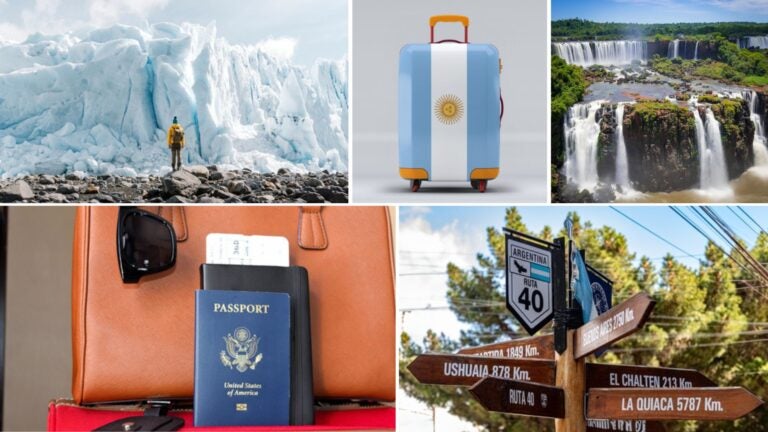Requirements to travel to Argentina from the USA
Find out what the requirements are to travel to Argentina from the USA so you can start your adventure on the right foot.
Planning your next adventure to the land of tango and asado? If you plan to travel to Argentina from the USA, make sure you understand the entry requirements so your trip begins smoothly. From exploring Buenos Aires’ vibrant culture to marveling at Patagonia’s dramatic landscapes or discovering the unique sights in the north, entry is generally straightforward for U.S. passport holders.
In this guide we cover everything you need to bring, from essential documents to practical tips for preparing your trip. We explain step by step what immigration requires, how to present each requirement and which situations could cause problems. This way you can focus on what really matters and enjoy your experience in Argentina from the very first moment. Let’s go!
Do I need a visa to enter Argentina with a U.S. passport?
No. If you have a U.S. passport and are traveling for tourism, you do not need a visa to enter Argentina. You can stay in the country for up to 90 days and may be able to extend your stay for another 90 days by applying for an extension with the National Immigration Office while you are there.
Keep in mind that your trip must be strictly for tourism, leisure, or visiting purposes. If you plan to work, study, volunteer in some cases, move to the country, or stay for more than three months, you will need to apply for a specific visa depending on the type of activity.
The most common visas for extended stays are:
- Work visa: If you have an employment contract with a company based in Argentina.
- Student visa: If you are going to pursue formal studies at an educational institution in the country.
- Temporary or permanent residence visa: For those who are moving for family reasons, investment, retirement, etc.
The best thing to do if you have any doubts is to check in advance and apply for these visas directly at the Argentine Consulate that covers your area in the United States. This way you can avoid confusion or delays in the process.
Is a passport one of the requirements for traveling to Argentina from the USA?
Yes, you need a passport just like you would for any other country. It’s your key to entering Argentina, so without a valid one, you won’t be able to get in and could even have trouble leaving the United States.
Having a valid passport means it must be issued by the U.S. government and be valid for at least six months from the date you enter Argentina.
Your passport should also be in good condition and have at least one blank page for entry stamps. While U.S. tourists don’t need a visa for Argentina, the entry stamp is required and serves as your official proof of entry.
It’s also a good idea for your passport to have a machine-readable zone or an electronic chip, as this speeds up immigration checks at the border and ensures compliance with international security standards.
If your passport is close to expiring or is noticeably damaged, it’s best to renew it before your trip to avoid any issues when entering or leaving the country.

Do I need medical or travel insurance to enter Argentina?
While it’s not required to enter the country, having health or travel insurance is highly recommended when traveling to Argentina from the United States, especially if you plan to explore different regions or stay for more than a few days.
Argentina has a public healthcare system, but tourists may face delays or limited access. If you need care at private clinics, which usually have better facilities, costs can be high without insurance coverage.
What is the difference between medical insurance and travel insurance?
- Health insurance covers medical care, including doctor visits, medications, hospital stays, and emergencies. It’s a smart choice for a longer stay in Argentina, giving you peace of mind that you’ll have prompt and quality care in case of any unexpected situation or accident.
- Travel insurance, on the other hand, covers more than just medical care. It can protect you against flight cancellations, lost luggage, trip interruptions, or repatriation. For shorter trips, this type of coverage is ideal. If you plan to ski, go rafting, paraglide, hike, or do any other high-risk activities, make sure your policy includes coverage for those sports.
For a worry-free trip, it’s best to get travel insurance that includes medical coverage of at least $30,000. This way, you’ll be protected against unexpected events without putting your savings at risk.
What other requirements are there for traveling to Argentina from the United States?
In addition to your passport, it’s wise to have a few other things ready to avoid any issues at the border. Make sure you have your return or onward flight, confirmation of where you’ll be staying, and proof that you can support yourself during your trip.
- Airline ticket: Sometimes airlines or immigration officers may ask you to show proof that you’ll be leaving the country. This doesn’t have to be a return flight to the U.S.; it can also be a ticket to another destination outside Argentina. The key is to show that you’ll depart before your allowed stay expires.
- Proof of accommodation: This could be a reservation at a hotel or Airbnb, or even an invitation letter from an Argentine resident if you’ll be staying at their home. While it’s not always required, it’s a good idea to have it on hand in case immigration asks for it.
- Financial resources: Argentina doesn’t set a specific amount you must have, but you should be able to show that you can cover your stay. Most travelers do this with international credit or debit cards, cash, or a recent bank statement. As a general guideline, having about $50 per day is considered sufficient.
Having these documents ready will make your immigration process smoother and help you avoid unnecessary delays. While many travelers pass through without any questions, it’s always better to be prepared.
That covers all the requirements for traveling to Argentina from the United States. As you can see, the process is straightforward and doesn’t require a lot of planning. Still, to make sure everything goes smoothly, it’s a good idea to organize both a physical and digital folder with all the documents we’ve mentioned.
Another thing to know is that currently there are no vaccination or health certificate requirements for U.S. citizens. You also don’t need to fill out any pre-travel immigration forms like in some other countries.
Final tips for traveling to Argentina from the United States
Argentina is a country to be savored, not rushed, and it cannot be fully experienced with a generic guide. Everyday moments can be just as remarkable as its iconic sights. Having a coffee on a Buenos Aires street corner can be as unforgettable as watching a glacier in motion. That is why, in addition to meeting the entry requirements for U.S. travelers, it is helpful to keep a few practical tips in mind to enjoy every moment and avoid surprises.
1- Choose the season according to the region you are going to visit
Argentina is vast and the seasons can vary dramatically from one region to another. If you want to visit Patagonia or the Lake District, the best time to go is between November and March, when the days are longer and the weather is more pleasant.
In northern Argentina, such as Salta and Jujuy, winter from June to August is dry and cool, perfect for exploring without rain or extreme heat. Buenos Aires is enjoyable at any time of year, but spring from September to November and fall from March to May are particularly lovely. Córdoba is best experienced in the milder seasons or in summer, when its clear rivers are at their most beautiful.
2. Stay connected with an unlimited data eSIM
Internet in Argentina can be spotty outside the major cities, so getting a Holafly eSIM is a great way to stay connected without relying on WiFi. With it, you’ll have unlimited data to travel across the country without any issues.
If you plan to work remotely while traveling through Argentina or stay for more than a month, we recommend Holafly Plans. With this subscription, you can choose between two options, 25 GB or unlimited data, and stay connected in over 170 countries, including Argentina. This means that if you plan to visit Chile, Uruguay, Paraguay, Brazil, or any other destination, you can keep using the same plan without any interruptions.
With Holafly, you’ll be able to use maps, transportation apps, translation tools, and stay in touch with your family from the moment you arrive, all without worrying about roaming charges.
Important: If you are a frequent traveler and want to stay connected without worrying about expensive roaming or looking for a new SIM at every destination, Holafly’s subscription plans are for you. With a single eSIM, enjoy internet in more than 170 countries for a fixed price and no surprises on your bill. Travel without limits and connect easily and securely! 🚀🌍

3. Bring several forms of payment and learn about the exchange rate
Argentina has a unique currency system, though it has become a bit simpler recently. You can bring U.S. dollars and exchange them without issues at authorized exchange offices or through legal channels that follow the official tourist rate, like Western Union or MEP. International cards are still useful for larger payments and reservations, and digital wallets are widely accepted, so paying won’t be a problem.
That said, while cards are accepted in most places, it’s common for small shops, markets, or independent tourist services to only take cash.
4. Don’t just use Uber – Use local apps or public transportation
Uber operates in some cities, but it isn’t fully regulated. In Buenos Aires, it’s usually easier to use apps like Cabify or BA Taxi, which work with licensed taxis. In other cities, like Mendoza or Córdoba, you can rely on official taxis or rent a car.
Buenos Aires’ subway and buses work well, but you’ll need a SUBE card, which is easy to get at kiosks or stations. For longer trips, there is a nationwide network of long-distance buses that connects the whole country.
5. Want to rent a car? Your U.S. driver’s license is valid
If you plan to explore remote areas, drive through Patagonia’s lakes, visit Córdoba’s dams, or tour wineries in Mendoza, renting a car can be a great option. A U.S. driver’s license is valid in Argentina for up to 90 days.
You don’t need an international driving permit as long as your license uses the Latin alphabet, is valid, and you carry it with your passport. Main roads are generally in good condition, but in rural areas you may encounter gravel roads, so drive carefully.
6. Vaccinations and healthcare
There are no required vaccines to enter Argentina from the United States, but it’s a good idea to be up to date on routine shots like tetanus and hepatitis A and B. In the summer and in subtropical regions, such as Misiones or Corrientes, dengue-carrying mosquitoes can be a concern. Use insect repellent, wear lightweight clothing that covers your arms and legs, and stay in accommodations with screens or air conditioning.
7. Keep an eye on your belongings in crowded areas
Safety can be a concern in Argentina. In big cities like Buenos Aires, Córdoba, and Rosario, theft happens fairly often and can sometimes be violent. That said, there are plenty of safe neighborhoods, so with some common sense and awareness, you can move around without worry.
Watch your belongings, particularly in busy tourist spots, on public transit, or at crowded events. Keep your bag closed, use your phone discreetly, and avoid carrying important documents with you constantly. Stick to well-lit, safe streets, and if you’re unsure, don’t hesitate to ask locals for guidance. Argentines are generally very friendly and happy to help you feel secure.
8. Plan your itinerary logically – Don’t underestimate distances
Argentina can’t be explored in just a week. With over 2,000 kilometers between Buenos Aires and Patagonia, and the north of the country also far away, it’s best to use internal flights for long trips and focus on a few key regions. You’ll get more out of seeing two or three areas well than trying to cover the entire country. For getting around within a province, local transport or organized tours can be a convenient option.
9. Although many people speak English, Spanish will open doors for you
In popular tourist spots, you’ll often find English speakers, especially among younger people. Outside of these areas, knowing some Spanish is important. Picking up a few key phrases like hello, thank you, or asking where something is can make interacting with locals much easier. Argentines also really value it when visitors try to speak their language.
10. Don’t just stick to Buenos Aires – Argentina has so much more to offer
Buenos Aires is exciting, but don’t miss out on the rest of the country. Argentina offers everything you can imagine and more. It’s no wonder that visitors are often amazed by its natural beauty and rich culture.
If you love nature, head to Patagonia. To explore ancient cultures, the north is the place to go. Wine lovers should not miss Mendoza, and for one of the world’s great natural wonders, visit Iguazú Falls. If you’re looking for unique beaches, the Atlantic coast or even the Tigre Delta can be a pleasant surprise. Each region has its own vibe, and discovering these contrasts is part of what makes traveling through Argentina so special.

Frequently asked questions about requirements for traveling to Argentina from the United States
With a U.S. passport, you can stay in Argentina for up to 90 consecutive days without a visa. If you want to extend your stay, you need to apply for a 90-day extension with the National Immigration Office before your initial period expires. You can complete the process in person or online, and you will need to pay a fee. Leaving the country and returning doesn’t automatically reset the 90-day period, so it’s best not to rely on this as a way to extend your stay.
Immigration officers don’t officially require it, but they may still ask to see it to make sure you aren’t planning to stay longer than allowed. Airlines can request it before you board as well. That’s why it’s a good idea to have a return or onward ticket ready when you arrive, whether you’re heading back to the U.S. or on to another destination.
You don’t need any specific vaccines to travel to Argentina from the United States. It’s still wise to be up to date on routine immunizations like tetanus and hepatitis A and B. If you’re visiting subtropical regions like Misiones or Corrientes during summer, be mindful of mosquitoes and take steps to prevent dengue.
Yes. A U.S. driver’s license is valid in Argentina for up to 90 days as long as it is current and uses the Latin alphabet. You don’t need an international permit. That said, some rental agencies may ask to see your passport and a credit card in the driver’s name as a guarantee.
The local currency is the Argentine peso (ARS). Most places accept cards, bank transfers, or QR codes, but people still use cash a lot in markets and small shops. It’s a good idea to bring U.S. dollars and exchange them at official exchange offices, or use Western Union for a better rate than banks offer. Having a card with no foreign transaction fees is also handy for withdrawals and payments.





 Language
Language 


















 No results found
No results found








